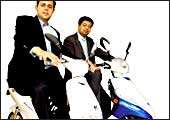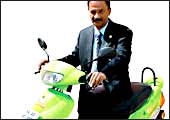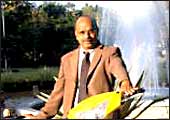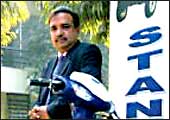 |
 |
 |
 |
 |
 |
| Mobile
Security
Today, it is all about information and how
the right information is sent to the right people at the right
time and right place. Uncertainty about how to secure mobile phones
in the face of increasing threats is slowing individual adoption
of mobile applications. There are many facets of mobile security,
including network intrusion, mobile viruses, spam and mobile phishing.
Analysts expect big telecom companies to develop security solutions
on various security platforms. |
|
Rough
Ride
These
are competitive times for the Indian aviation industry. As salaries
zoom, players are scrambling to find profits. Even the state-owned
Indian is now seeking young airhostesses to take on the competition.
It is planning to introduce a voluntary retirement scheme for airhostesses
above 40 years. On an average, they draw a salary of Rs 5 lakh a
year. The salaries of pilots, too, are soaring. According to industry
estimates, the country needs over 3,000 pilots over the next five
years.
More
Net Specials |
 |
 |
 |
 |
| 
|
 |
| |
|
 |
 |
 |
| |
GREEN
TECH
Electric Dreams |
| Last year, of the 7 million two-wheelers
sold in India, just 50,000 were electric. But with a handful of
manufacturers revving up, the market is set to double this year.
|
| By Venkatesha Babu & Aman Malik
|
 |
| Ultra Motor's Ghoshal (L) & Hero Exports'
Munjal: A big player enters the EV market |
Ever since
he graduated from an engineering college way back in 1973, Anil
Ananthakrishna has spent his life developing electric two-wheelers.
His first, named Vidyut 24 (the former means electricity in Hindi
and the latter indicates the vehicle's power in volts), was launched
in 1983. It was a technical success, says Anil Ananthakrishna, but
a commercial failure for a number of reasons. His company Eko Vehicles
Pvt. Ltd did not have a proper distribution system, its manufacturing
system was not perfected, and since the sales volumes were low,
retail prices could not be brought down. "At first, a radical
idea is ignored, then ridiculed and finally accepted. I think the
time for acceptance has arrived," declares Eko's Chairman &
CEO.
 |
| Eko's Anil Ananthakrishna:
"At first, a radical idea is ignored, then ridiculed
and finally accepted" |
It's once again one man who is passionate about
the electric vehicle (EV) technology betting his company on it.
But this time around, there's a difference. Soon after Eko launched
its new electric scooter Eko Cosmic I in January 2005, a small number
of other players have entered the market as well. The UK-based Ultra
Motors, which is an EV technology provider, has tied up with Hero
Cycles to market a range of electric cycles and scooters in India.
Another Ludhiana-based bicycle manufacturer, Avon Cycles, has also
launched a 35-volt "E-bike" that can do 40 km on a single
charge. Electrotherm India and Standard Batteries are two others
that have forayed into electric two-wheelers (see Who's on the EV
Bandwagon?). "There is a wide (market) gap between a bicycle
and, say, a scooter or a motorbike. EVs will serve as great in-betweens,"
says Deba Ghoshal, Director (Marketing), Ultra Motor Company. Adds
Onkar Singh Pahwa, MD, Avon Cycles: "China is witnessing a
revolution of sorts. They sold 7.5 million E-bikes in 2004 and 10
million in 2005. So, we expect at least a market of 2 lakh vehicles
in India this year."
| WHO'S ON THE
EV BANDWAGON? |
| An assortment of small and big
companies.
|
Company
Product/Price/Units Sold What's the Plan?
Electrotherm India
YOBykes/ Rs 16,000-36,000/ N.A.
Move up from low-power scooterettes to higher-power vehicles
in the next few months, backed by 250 exclusive YoWorld
and YoPoint retail outlets by the end of March 2007
Standard Combines
Standard/ Rs 27,000/ 1,400
This combine harvester manufacturer moved into cranes and
then into two-wheeler EVs two years ago; plans to have 400
dealers nationwide for its EVs
Hero Cycles/ Ultra Motors
E-bikes & E-scooters/ Rs 15,000-28,000/ N.A.
Two-wheeler giant Hero Group moves into the market and ties
up with a UK-based firm to try and translate the latter's
success in the Indian market
Avon Cycles
Avon E-bike, Avon E-lite, Avon E-plus/ Rs 16,500/ 1,500
Punjab-based cycle manufacturer moving up the chain to tap
the booming EV market and plans to target production at
10,000 units a month eventually
Eko Vehicles
Eko Cosmic/ Rs 25,000/ 2,500
Second attempt at two-wheeler EVs, this time backed by tax
exemptions from state governments
Kaiser Auto Moto
Zuck E-bikes/ Rs 16,500-40,000/ N.A.*
After establishing a strong presence in the Chinese market,
the company plans to do the same in India as well. The company
wants to sell at least 1,000 bikes in the first year
N.A.: Not available *Kaiser plans to launch its vehicles
in India in mid-April Source: Companies
|
Opportunities Galore, But...
 |
| Electrotherm's MD Mukesh Bhandari:
7.7 million EVs over the next decade, says the firm's
research |
There's no doubt that India is a two-wheeler
nation. In 2005-06, more than 7 million two-wheelers were sold in
the country. Of these, 5.81 million were motorcycles or step-throughs,
9.08 lakh were largely scooterettes and another 3.32 lakh were mopeds.
A bare 50,000 were electric two-wheelers. By the end of this financial
year in March, two-wheeler sales will surge past the 8-million mark,
and ev sales should double to 1 lakh. One reason behind it is, of
course, the rising affluence of India's middle-class consumers.
Another is the soaring cost of fossil fuel (read: petrol), and yet
another, the concern over global warming due to emissions. Last
year, India imported oil worth Rs 1,97,600 crore, of which vehicles
consumed 40 per cent. If that bill can be cut by even 1 per cent,
that's Rs 7,900 crore in annual savings. "Market research undertaken
by us indicates a potential demand for 7.7 million evs over the
next decade," says Avinash Bhandari, Director (Operations),
Electrotherm.
 |
 |
| Standard Combines’ Choubey:
“It was only last year that companies evinced great
interest in this segment” |
Kaiser Auto Moto MD Wasi-Ur-Rahman:
“India is the next big opportunity in this
fast-growing market” |
The concept of EVs is not new. A workable prototype
was first produced in America as early as 1834, and till the late
1890s, EVs were considered to be the future. But then the internal
combustion engine came along and quickly became the standard on
most vehicles. EV-related work was put on the backburner by most
vehicle manufacturers, and research limped along. As a result, EVs
today have several handicaps. They cost, on an average, 50 per cent
more than their IC-counterparts. Explains Ghoshal: "The motor,
controller and batteries together constitute two-thirds of the vehicle
cost," implying that there's little scope for reducing the
vehicle price. Why do these components cost so much? Simply because
there haven't been any technological breakthroughs in any of them,
therefore, costs have remained static. In a price-sensitive market
like India, higher cost of EVs has meant slower adoption. That apart,
there are logistical issues. Conventional lead acid batteries offer
limited range-for instance, most EVs today can at best do 80 km
on a single, six-hour charge (see The EV Pros and Cons). To make
matters worse, there are no public electric charge stations in the
country.
| THE EV PROS
AND CONS |
| Currently, disadvantages outweigh
the benefits of electric two-wheelers.
|
| Pros
Lower cost per kilometre (Rs 0.40/ km) vs petrol-driven
vehicles (Rs 2/ km)
Lower cost of maintenance since there are fewer moving parts
Is environment-friendly since EVs have zero harmful emissions
Some bikes don't require a licence to operate and others
are auto-geared
Lighter and more efficient Lithium Ion batteries are being
developed
Growing acceptance as a second two-wheeler for short trips
Load carrying capacity is getting better with new models
Entry of players like Hero Group lends credibility to
the sector
Cons
Mileage per charge is as little as 50-80 km and overnight
recharge is mandatory
The electric motor and batteries need to go through costly
overhauls regularly
Availability, since EV makers are unknown and retail spread
limited
Limited speed and pick up; therefore, limited to personal
commuting
No public charging points (paid or unpaid) in India for
now
More expensive than equivalent petrol vehicles due to tax
structure
Yet, current electric two-wheelers can carry only 100-120
kg of weight
Most players import Chinese CKDs and assemble. After sales
service is poor |
 |
| Avon Cycles' Onkar Singh Pahwa:
"We expect at least a market of 2 lakh (electric) vehicles
in India this year" |
Recent improvements in battery technology and
the steady rise in fuel prices have made EVs attractive. "It
was only last year that companies evinced great interest in this
segment," says V.K. Choubey, Deputy Director of Standard Combines.
Ananthakrishna's firm has sold 2,500 Eko Cosmics since its launch
in January 2005, and Standard has done about 1,400. But for EVs
to become affordable, the government needs to chip in too. In particular,
the manufacturers want excise and sales tax benefits, besides changes
in the Automotive Research Association of India (ARAI's) guidelines.
"Currently, any electric motor above 250 Watts cannot get ARAI
clearance. There's no explanation offered," says Ghoshal. "Throughout
the world, motors are getting more and more powerful from a performance
and safety perspective," he adds. Ananthakrishna agrees, stating
that arai's guidelines for EVs are archaic. He says the regional
transport authorities (RTOs) need to be educated about EVs, since
sometimes they either refuse to register such vehicles or unnecessarily
harass the owners. "EVs will remain (a niche segment) for the
next two years and in the third year we will see it gain critical
mass and become mainstream," says Naveen Munjal, Chief Executive
of Hero Exports.
| BEYOND ELECTRICITY
|
| Can biofuels upset the EV calculations?
|
| While EVS have caught the attention and imagination
of a large section of the alternate fuel market, there are
quite a few other options. These include ethanol, bio-diesel,
natural gas, propane and hydrogen. Ethanol in India is derived
from molasses, a by-product of sugar manufacturing. India
is the second-largest producer of sugarcane (at 280 million
tonnes per annum, next only to Brazil) and is already experimenting
with ethanol-blended petrol. There are nine states where petrol
is being blended (5 per cent) with ethanol, and the Union
petroleum ministry is looking at enhancing the blend ratio
to 10 per cent and making it a standard across the country.
Bio-diesel is derived from vegetable oils and animal fats.
In India, though, bio-diesel is derived mainly from the
seeds of Jatropha plant and that of Indian beech tree. Since
Jatropha can be grown on wastelands and yields more than
four times as much fuel per acre as soyabean and nearly
10 times that of corn, the Indian government has encouraged
cultivation of this shrub-like plant. Even private sector
players such as Reliance Petroleum have been attracted to
the potential of this shrub.
Compressed Natural Gas or (CNG) is a widely used alternate
fuel in India. The country is believed to have more gas
than petroleum reserves. Propane or Liquefied Petroleum
Gas (LPG) is another widely used alternate fuel. Even mainstream
car manufacturers such as Maruti Udyog today offer an LPG
alternative in some of their vehicles. Hydrogen fuel vehicles
are considered the Holy Grail, as hydrogen is abundant in
nature. However, the technology is yet to be perfected.
|
For entrepreneurs such as Ananthakrishna, who've
spent decades pursuing their electric dreams, two years should
pass in a blink.
-additional reporting by Rahul Sachitanand.
|
| |
  |
|
 |










